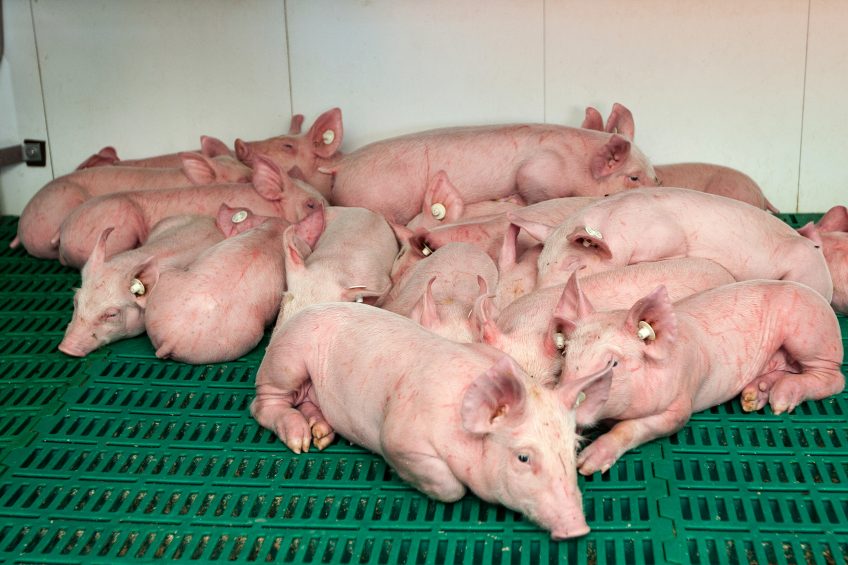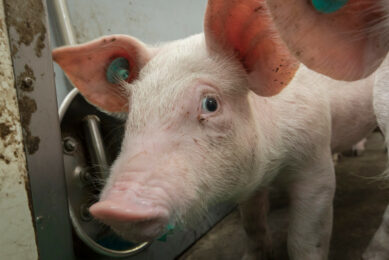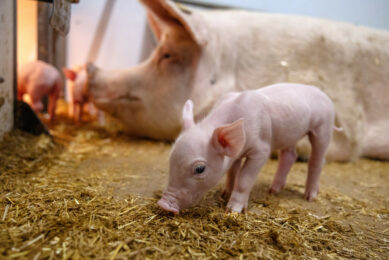The gut’s barrier function: Essential for gut health

The importance of the gut for pig health cannot be underestimated. It is here where it is determined which micro-elements gain access to the pig. How to assess the functioning of this barrier function? There are various ways – with live pigs or in a laboratory.
The gut mucosa acts as a filter between the harsh environment of the intestinal lumen and the finely regulated homeostasis of body tissues. The gut mucosa not only regulates the passage of nutrients and molecules, but also avoids penetration of bacteria, toxins and dietary antigens entering the submucosal tissues or systemic circulation. An efficient gut barrier has many components such as the mucus layer and its associated microbiome, immune effectors and paracellular tight junction integrity. Studies have shown how disturbances of the gut barrier can influence animal performance and health.
The role of tight junctions for gut health
The intestinal mucosa is composed of columnar epithelial cells (also known as epithelium), as well as the underlying lamina propria and muscular mucosae. There are two routes for transport beyond the epithelium, i.e. transcellular (through the cells) and paracellular (in between the cells). The regulation of gut barrier function is mainly dependent on the paracellular route (see Figure 1). Tight junctions seal the space between the adjacent epithelial cells, and selectively control the passive diffusion of ions and other small solutes through the paracellular route.
Thus, tight junctions play an essential role to maintain the gut barrier integrity. Tight junctions are multi-protein complexes, composed of so-called ‘transmembrane proteins’ and regulatory molecules that include kinases.
The gut barrier is not only essential for preventing penetration of bacteria, toxins and dietary antigens, but also for maintenance of epithelial ion gradients that drive active nutrient absorption, such as the absorption of glucose. In addition, the selective permeability of tight junctions allows transepithelial gradients to drive passive paracellular transport of ions and water.
Claudins and occludin
The most important of the transmembrane proteins are the claudins, which define several aspects of tight junction permeability. To date, 27 mammalian claudins have been described, but not all these genes are found in all mammalian species and there expression is largely tissue dependent and regionally distributed. Occludin, another transmembrane protein, interacts with claudins and actin. In addition, there are various peripheral membrane proteins playing a role here.
Important to understand here is that the tight junction is selective for both size and charge. As for size: allowed is a limited flux of proteins and lipopolysaccharides, but entire bacteria cannot pass. As for charge: the tight junction can be selective for substances. These properties may be regulated individually or jointly by physiological or pathophysiological stimuli.
Figure 1 – Routes of transepithelial transport.

For example: Weaning stress
Weaning stress causes increases in the corticotropin releasing factor found in blood and gut mucosa. This in turn evokes degranulation of intestinal mast cells. Pro-inflammatory cytokines and proteases are released that alter the tight junction protein formation and distribution. As a result, a transient increase in paracellular permeability is observed in the acute phase post-weaning. Some authors suggest that this is an important entry route for bacteria like Streptococci. The transient increase in paracellular permeability might allow further leakage of luminal material and perpetuates the pro-inflammatory cycle, increasing enteric disease risk. A recent study showed that cromolyn, a mast cell stabilising agent, improved intestinal barrier function associated with enhanced piglet performance after weaning.
For example: Oedema disease
Another example is oedema disease in piglets. Oedema disease, caused by the Shiga-like toxin type II variant from some Escherichia coli strains, is associated with the process of weaning but requires a disturbed gut barrier function in order to enable large toxin molecules to pass through the epithelium.
To date, there are several ways to evaluate the gut barrier via determining the gut permeability, by either in vivo or in vitro/ex vivo methods. A brief overview of some widely used methods for evaluating the gut barrier and the implications of the results is given here.
Measuring gut barrier in vivo
In vivo determination of gut barrier can be achieved by the measurement of the flow of oral taken non-digestible probe molecules from the intestinal lumen to blood or urine. The most widely used markers in humans and animals are small saccharides, for example, sucrose, mannitol and lactulose, or radiolabeled probes.
An increase in the lactulose/mannitol ratio indicates a decrease in the gut barrier function. However, results of the in vivo method lacks detailed information about the barrier function at a specific site of the gut. In addition, several factors like the metabolism, excretion and the distribution of the markers in the body, as well as the kidney function may all interfere with the results. In weaning pigs, it has been reported that the weaning process disturbs the paracellular route of the small intestine, which is based on the recovery of lactulose.
Measuring gut barrier ex vivo
In pigs, gut barrier function has been extensively assessed in ex vivo studies with a so-called ‘Ussing chamber technique’. In Ussing chambers, gut mucosa from a specific region of the intestine is surgically cut out from the animal, and then mounted between chambers, in order to simulate the in vivo environment.
Several parameters can be tested in the Ussing chamber system, including the transepithelial electrical resistance (TEER) and short-circuit current (Isc), as indicators of gut integrity and transepithelial ion transport, respectively. Also, different marker probes can be added to the mucosal side, then their passages can be determined through measuring their appearance in the serosal side.
The TEER is a widely used indicator of the gut barrier integrity. An increased TEER represents decreased paracellular permeability, whereas a decreased TEER represents increased paracellular permeability. Many experiments with piglets and broilers have found changes in TEER by environmental challenges (heat stress), contaminants (Salmonella), feed formulation (protein source) and feed additives (probiotics, essential oils, selenium). Recently, a team at Ghent University found that a potentiated source of zinc oxide (HiZox), supplemented at 110 or 220 mg Zn/kg, could improve the gut barrier integrity, indicated by an increased TEER value, as compared to regular ZnO at 110 mg Zn/kg, but similar to regular ZnO at 2,500 mg/kg.
The Isc is defined as the charge flow per time when the tissue is short-circuited. The Isc can also reflect the net ion transport across the epithelial tissue in basal conditions or stimulated by e.g. nutrients (glucose, amino acids).
Gut barrier = gut health
In summary, an efficient gut barrier is essential for gut health. A disturbed barrier function might allow leakage of luminal material and promote pro-inflammatory conditions, increasing enteric disease risk. Several in vivo and ex vivo methods are available, and one should consider them as complementary for the assessment of gut barrier integrity. With orally administered marker probes, gut integrity can be studied over time without killing the animal, whereas ex vivo methods allows the measurement at a specific region of the intestine. Furthermore, it is recommended to combine these functional assays with analysis of the actual components that make up the intestinal barrier, such as mucins and tight junction proteins. This approach will strengthen our understanding of the regulation of the gut barrier.
References available on request.











